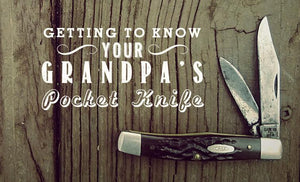This article inspired a book! A few years after writing this article, a publisher reached out to me and asked for a book on the subject of pocket knives. I’m happy to announce it’s published and available for purchase on Amazon!
The Guy’s Guide to Pocket Knives is filled with nostalgia and humor as I take the reader through the history of the pocket knife, the types of knives, locking mechanisms, and blades, as well as fun projects and some survival tips. Pick up a copy here!
Many men have been fortunate enough to have one of their father’s, grandfather’s, or great-grandfather’s closest and most prized possession bestowed upon them: their pocket knife. The value of this is not in the object itself, but in knowing that it traveled in the pockets of these respected men, was held in their hands thousands of times, cared and maintained, and used innumerable times in the daily tasks of their life. The pocket knife is special. For many, being handed a pocket knife was your first sign of acceptance into the world of men — You have something dangerous now that must be treated with respect and you are trusted to do so.
That being said, it is likely the pocket knife you may hand your sons is not the same as your grandpa carried. Most men opt for the Every Day Carry (EDC) single blade, with some nifty features cleverly built-in: a bottle opener, carabiner, glass breaker, seat belt cutter, etc. Unfortunately this simplistic model of knife, as well as the structure of modern life, has many of us at a loss for why grandpa needed two or three different blades. I mean, having a few extra helps when you chip one or the blade begins to dull, but is it really necessary? We forget that there was a time when tools were paramount to a man’s life, and the old motto, “The right tool for the job” was put into practice every day.
This article covers the purpose of the different blades on those wonderful knives and may give you a glimpse into some of the ways grandpa used his pocket knife.
— I want to thank W.R. Case & Sons Cutlery Co. at the outset of this article. Not only did they supply a great collection of knives for the article photos, but they were down-to-earth and proud to continue their legacy of making knives in America which they have been doing since 1889. —
Why So Many Blades?
The older style pocket knives were made to fit the line of work of their owner. In other words, the blade configurations on your knife reflected kind of work you did. Knife names like Trapper and Stockman make sense when you understand their intended use.
The Stockman
The Stockman configuration is a favorite of cattlemen and others that tend to herding animals.

Case Stockman Knife with Clip, Sheepsfoot, and Awl blades. (Click for larger)
Clip Point Blade
The most common blade on any knife is the Clip. The elongated tip aids in a variety of task from skinning to deboning. It is the most versatile of all blade types.
Sheepsfoot Blade
The Sheepsfoot blade was designed to trim sheep’s hooves. The dull back and rounded point allows pressure to be applied by the fingers without risk of being cut. For this reason, the Sheepsfoot is also adept at whittling.
Awl or Punch Blade
While an Awl blade may not appear useful for a pocket knife, it can perform the one task with great proficiency the other blades lack: puncturing. Blades that have the point aligned with the center of the knife are best at this because the force can be centralized with less concern of the knife glancing off or closing. The Awl would be used to puncture hides to string them together, and punch holes in leather for on-site repairs.
Get the Stockman from Amazon!
The Trapper
The Trapper may be the most common configuration in pocket knives. The blades on this model are preferred by fur traders and hunters.
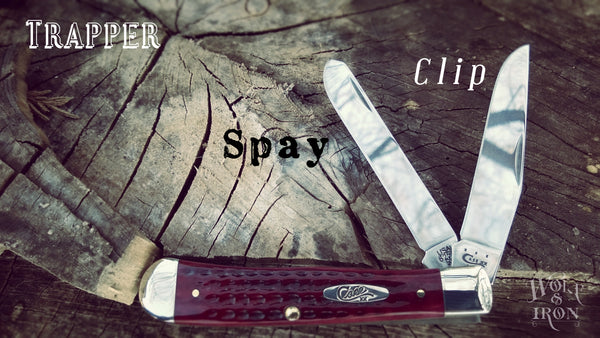
Case Trapper Knife with Clip and Spay blades. (Click for larger)
Spay Blade
Once used to neuter livestock, the Spay blade is commonly used by hunters and fur traders. The quickly curving point and dull tip make accidental puncturing unlikely.
Get the Trapper from Amazon!
The Seahorse Whittler
Designed as the name intended. While whittling may seem like a spare time hobby today, it was actually a necessary everyday practice on the farm, in the woods, or on a ship. Need to fit a new handle to your axe? You are going to do some trimming. Need to rig up some part for the ship and all you have are pieces of raw wood? Having a knife like this may be a life saver.
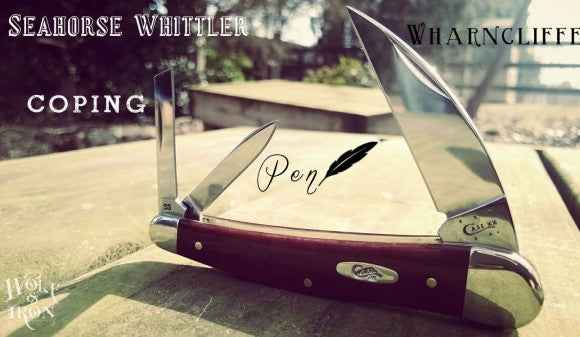
Case Seahorse Whittler Knife with Wharncliffe, Pen, and Coping blades. (Click for larger)
Wharncliffe Blade
The exact origins of the Wharncliffe blade is unknown but they are favored by sailors. The sloping back of the blade reduces risk of damaging their work or puncturing their hands in the unsteady environment of a ship. The tip is pointed which, unlike a Sheepsfoot, allows for some puncturing, and the straight edge can slice off wider swaths of wood than a Clip Point.
Pen Blade
The Pen blade was originally used for trimming quills also known as ‘dressing’. With the invent of the drip pen in 1820, the use of pen knives changed to stationary openers and general use knives but the name stuck. The larger sibling of the Pen is called the Spear blade (not pictured).
Coping Blade
Similar to a Sheepsfoot but with an angled point, the Coping blade is used for making cuts in tight areas or curved cuts. It is similar to a coping saw, without the teeth, and is a favorite of carpenters and electricians.
Get the Seahorse Whittler from Amazon!
The Fishing Knife
A knife designed especially for fisherman. With a longer clip blade for getting around bones and special blades not found elsewhere, this one is great to keep in the tackle box.
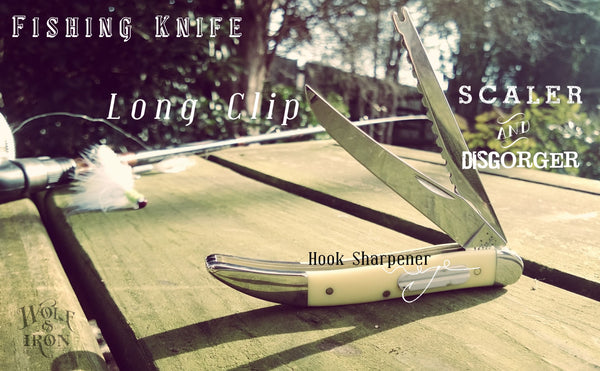
Case Fishing Knife with Long Clip, Scaler and Disgorger, and Hook Sharpener. (Click for larger)
Scaler and Disgorger Blades
The fish Scaler blade on this knife is used as you would expect. The not-too-sharp edge allows the blade to get under the fish scales and flake them off without cutting into the skin. The Disgorger, is used for hook removal by placing the notched end on the hook and pushing allowing for more control and safety than you can get with your fingers.
Hook Sharpener
A special feature only found on the Fishing Knife, the Hook Sharpener will keep your hooks ready to bite.
Get the Fishing Knife from Amazon!
The Hawkbill
The Hawkbill knife has many uses but is primarily found in the hands of gardeners.

Case Hawkbill knife. (Click for larger)
Hawkbill Blade
The large blade and curved tip, resembling a hawk’s beak, makes pruning trees and plants much easier. If you have ever tried to prune a tree with a typical knife, you quickly realize the slippery area underneath the bark (known as the cambium layer) makes this nearly impossible. The hooked end of the Hawkbill acts as a stopping point and makes this job much easier.
The Hawkbill knife style is often used by electricians as well. Splitting a wire pair down the middle or cutting wires is similar to pruning.
Get the Hawkbill from Amazon!
The Equestrian
If your grandpa was a horse lover he may have owned one of these.

Case Equestrian knife with Clip blade and Hoof Pick. (Click for larger)
Hoof Pick
The Hoof Pick is a common tool for those caring for horses. It is specially designed to clean an area of a horse’s hoof called the frog. This had to be done daily and should be done before and after riding to remove any rocks or debris.
See the image below to get an idea of how this would be done.
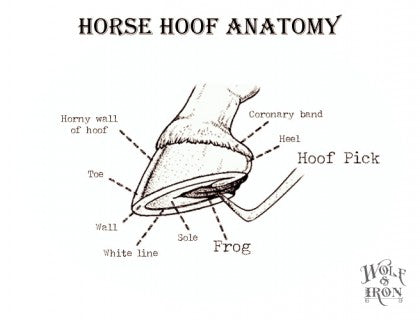
The Anatomy of a Horse Hoof with Hoof Pick. (Click for larger)
Get the Equestrian from Amazon!
Final Thoughts
Although Case has been around for a long time, they aren’t the only ones to produce the familiar style of pocket knives. Whether it’s a Case, an old Sears & Roebuck, or an unknown brand, if it was special to your father or grandpa it should be special to you. Keep it sharp, use it wisely, and you can hand it down to your son when the time comes.
And, if you have more than one son to bestow a knife upon or you want to start this tradition, Case knives are still being made with quality you can trust to span the generations. You can head over to their website, find a local merchant, or, of course, Amazon.

